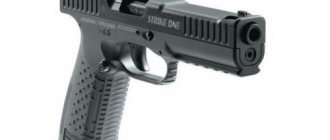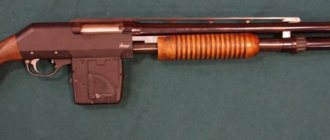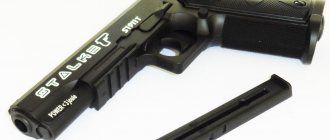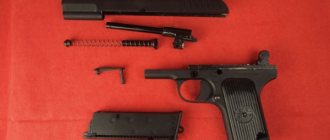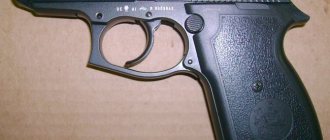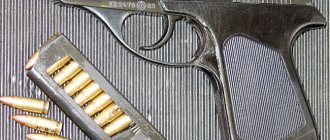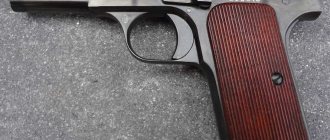The development of the SPS pistol was started in the 90s at the Central Research Institute of Precision Engineering (Klimov) by designers Pyotr Serdyukov and Igor Belyaev chambered for the 9x21mm (SP-10) cartridge of Yuryev A.. This model was the main participant in the army competition on the theme “Rook”. The pistol, previously known as the index RG055, "Gyurza" and SR-1 "Vector" was adopted in 2003 by the Russian Army and the Ministry of Internal Affairs, under the designation SPS (Serdyukov Self-Loading Pistol). Until 2003, the SPS was adopted by Russian security forces under the designation SR-1 “Vector” in 1996.
The operating principle of the automation is based on the use of recoil energy during a short stroke of the barrel and rigid locking of the larva, swinging in a vertical plane, located under the barrel. Double-action trigger mechanism, with a semi-open hammer, accessible for cocking with the thumb of the holding hand.
The SPS has two automatic safeties, one is made in the form of a button located on the back of the handle, the other is located on the trigger.
Now the shooter did not need to waste time removing the pistol from the safety catch; this design solution ensures the constant combat readiness of the weapon and the safety of handling it.
The pistol frame is made of steel. The handle and trigger guard are one piece and are made of durable plastic with a slightly rough surface. The size of the trigger guard has been increased, which allows shooting with thick gloves.
The sighting device is located on the bolt casing. A permanent rear sight with a rectangular slot and a front sight that does not produce glare in the direction of the rear sight. White inserts are installed on the rear sight and front sight, making it easier to aim at twilight. It is possible to mount a flashlight and a laser laser.
For shooting, SP-10 and SP-11 cartridges, specially designed for SPS, are used. The pistol cartridge - 9x21 (Central Research Institute of Precision Engineering index - RG052) is a completely new development that meets modern requirements for penetration of various obstacles. The cartridge was developed by leading engineer Alexey Yuryev. The cartridge provides penetration of body armor containing one or two titanium plates 1.4 mm thick and 30 layers of Kevlar at ranges up to 100 m. At ranges of up to 50 m, a pistol bullet pierces a steel sheet 4 mm thick. It can also pierce the cylinder head block of a car engine.
In terms of stopping effect, the cartridge bullet is 1.3-1.8 times superior to similar pistol cartridges of domestic and foreign production. After being adopted for service, the RG-052 cartridge was given the official name SP-10. Feeding is carried out from a box magazine with 18 rounds, staggered and not protruding from the handle. The magazine body has rows of holes that make it lighter and allow you to determine the number of cartridges in it.
SPS is designed to engage living targets in body armor of I, II and III protection classes (type Zh-81, Zh-86-2), corresponding to foreign standards NILECJ-STD-0101.01 and MIL-C-44050, as well as various technical means (vehicles , cabins and antennas of radar systems, missile bodies, etc.) at ranges up to 100 m.
The gun operates reliably in various operating conditions, in the temperature range from -50 C to +50 C.
Disassembly and assembly of the Serdyukov SPS self-loading pistol:
To clean the gun and inspect it, the gun is partially disassembled. Partial disassembly is carried out without the use of special tools. To do this you need:
1. Set the shutter to stop. Holding the pistol with the unloaded magazine by the handle, move the bolt to the rear position. Check to see if there is a cartridge in the chamber. Release the bolt and control release the hammer.
2. Separate the store. Holding the pistol by the handle, press the magazine release button with your thumb and, holding the magazine with the other hand by the cover, remove it from the handle.
3. Separate the barrel delay. Turn it 90º counterclockwise and remove it from the frame.
4. Separate the shutter. Remove the bolt from the slide stop and, moving it forward, separate it from the frame.
5. Disconnect the barrel from the bolt. Holding the bolt with one hand, press the protruding part of the wedge with the thumb of the other hand and, moving the barrel a little forward, separate it from the bolt.
6. Remove the return spring with the stop from the barrel.
7. Separate the contactor from the barrel.
Note: if the magazines are equipped with cartridges, then for disassembly it is necessary:
1. Separate the store.
2. Pull the bolt back with your left hand and, holding it in the rear position, separate the barrel stop.
Reassembling the pistol after partial disassembly is done in the reverse order.
Caliber 9 mm Cartridge 9x21 mm SP-10, SP-11
Weight without cartridges 0.99 kg Weight loaded 1.18 kg Weapon length 200 mm Barrel length 120 mm Height 145 mm Width 30 mm Muzzle velocity 410 m/s (7N29) Combat rate of fire 36 v/m Magazine capacity 18 rounds Sighting range 100 m
It became more convenient to shoot
One of the shortcomings of SPS pistols identified during combat operations is the inconvenient safety system. One of them is located on the trigger, and the second on the weapon control handle. In order for a shot to occur, you must simultaneously hold down two keys, tightly grasping the pistol with your palm. If there are no problems with the first one, then the second button, due to its small size, can fail at any time. This problem is especially relevant during the fight for fighters with small hands. Some of them wrap the key in the pressed position with electrical tape. To eliminate this flaw, the designers of the SR1MP significantly enlarged the safety button located on the back of the handle. Now it has become much more convenient to shoot.
Tactical and technical properties of SPS "Vector" (SR1M)
Designer…………………Peter Serdyukov Years of production…………………since 1996
Weight, kg……………………0.9 (without cartridges), 1.11 (equipped) Length, mm……………………200 Barrel length, mm………………………120 Width, mm… …………………34 Height, mm………………………145
Cartridge……………………9×21 mm Caliber, mm…………………9 mm Operating mechanisms…………………recoil with small barrel stroke, double action trigger Initial bullet speed, m /s……………………410 Sighting range, m…………………100 Type of ammunition…………………magazine for 18 rounds
Technical indicators
The Gyurza pistol has many positive qualities, the main ones being self-loading, precaution, and convenient design.
Serdyukov's self-loading pistol makes it possible to increase the speed of completing the task and avoids serious consequences, since when a loaded magazine is connected, there is no need to pull back the bolt, that is, shooting can begin immediately after the magazine release clicks.
The precaution of this pistol is the presence of two types of safety systems. The first system is a lever (handle) safety, and the second safety is an element that locks the trigger system until it is used.
The thoughtful design of the Gyurza pistol made it possible to increase such technical characteristics as shooting accuracy due to the barrel bore locking system, which is closed thanks to a swinging cylinder. The remaining technical components are made of reliable material that is shockproof and frost-resistant.
Video of the SPS Vector pistol (SR1M)
The development of a new pistol complex (9mm high-efficiency cartridge + pistol) was started at TsNIITOCHMASH in the early 1990s as part of the army competition "Rook", while two basic designs were developed - with a blowback bolt and a movable barrel, and with the introduction of recoil energy with a small stroke the barrel when it is tightly locked. The first system was not successful, but the pistol of the second design, although rejected by the army, aroused the enthusiasm of various Russian special services in the mid-1990s, namely the FSB and the FSO.
The main advantage of the new pistol was its very high efficiency against targets protected by body armor or obstacles such as the sides of a car, which is why the pistol received a specially made 9x21mm SP-10 cartridge (original designation RG052) with an armor-piercing bullet. Later, in addition to the SP-10, a number of 9x21mm caliber cartridges were also developed, including cartridges with expansive and low-ricochet bullets. With the SP-10 cartridge, the pistol is capable of successfully hitting targets wearing class 3 body armor at ranges of up to 50 meters and even further. In addition, the SPS pistol has a fairly high magazine capacity and is adapted for rapid use.
During production and operation, the Serdyukov SR1 pistol underwent a number of configurations, and is currently produced under the symbol SR1M. This option has slightly improved ergonomics due to the configuration of the magazine latch design, the increase in the size of the automatic safety button on the handle and a number of other configurations. In addition, customers are offered the SR1MP option, in which the SR1M pistol is equipped with a special adapter with one or 4 Picatinny-type rails, as well as a quick-release muffler. It should be noted that currently 9x21 live ammunition is produced exclusively in versions with a supersonic bullet, and therefore the effectiveness of suppressing the sound of a shot is somewhat limited.
The SPS / SR1M pistol is built on the basis of automation with the introduction of recoil energy with a small stroke of the barrel and its rigid locking by a larva swinging in a vertical plane located under the barrel (similar to the Walther P-38). The return spring is placed around the movable barrel, which is why a patented solution is used in the form of a special stop for the rear end of the spring, while the front end of the spring rests against the bolt. The pistol frame has a composite structure - its upper part is made of steel, and the pistol grip with the trigger guard is made of durable plastic. The trigger mechanism of the pistol is double action, with an open hammer. The peculiarity of the trigger is that the self-cocking mode only works when the trigger is placed on the intermediate “safety” cocking.
The pistol does not have non-automatic safeties; instead, there are two automatic safeties - on the trigger and on the back of the handle. With all this, if the pistol grip is incorrect or incomplete, under stressful conditions the hand safety may not be turned off, which will lead to the impossibility of firing with disastrous consequences for the shooter. Therefore, on earlier versions of the CP1 pistol, some users permanently disable the handle safety by wrapping the handle with tape or insulating tape. SPS sights are fixed and have snow-white inserts to make aiming easier. The cartridges are fed from detachable box magazines with a capacity of 18 rounds. The magazine release button is located behind the trigger on the handle. Early production standards SR-1 did not have a slide stop; SR1M pistols received a slide stop that was automatically turned off when a new magazine was inserted into the pistol.
A bulletproof vest won't save you anymore
The prerequisites for the creation of such a pistol appeared in the 80s, when the period of widespread equipping of the armed forces of most world countries with personal protective devices - body armor - began. This in turn led to the development of weapons capable of coping with such protection. SR-1 was specially created for the competition of personal weapons of Russian servicemen. According to the competition results, the Yarygin pistol won, but the development of the SR-1 became of interest to special forces.
In the mid-90s, “Gyurza” fell into service with the FSO and FSB intelligence services. The main reason for the interest was the fairly powerful pistol cartridges. The development of ammunition for the SR-1 was carried out specifically for special operations. The powerful performance of the 9x21 cartridge is ensured by the mass of the bullet itself, which has a steel core inside it. Such a bullet copes with a 6 mm thick steel plate and 30 layers of Kevlar. “Gyurza” not only penetrates a door and body armor, but also penetrates a protective helmet and is capable of stopping a car. The competitive characteristics of “Gyurza” have become even more relevant in the modern world.
Specifications
Now, having dealt with the cartridge, let's move on to the technical characteristics of the SR-1 itself:
- Length – 195 mm;
- Height – 145 mm;
- Width – 30 mm;
- Weight without cartridges - 950 g;
- Weight with cartridges – 1200 g;
- Double-row magazine with a capacity of 18 rounds;
- Rate of fire – 40 rounds per minute;
- Target firing range – 100 meters;
- “Operating” temperature range: -50 o C/ +50 o C.
As mentioned earlier, “Gyurza” went through more than one demanding competition and many improvements before achieving such parameters.
How the gun works
To better understand the mechanics, let’s read the instructions for its partial disassembly. Let’s imagine that the described “Gyurza” pistol lies in front of us.
Procedure:
- According to safety precautions for handling weapons, when disassembling any sample, you must first make sure that the magazine and chamber are empty. The magazine is inspected visually, after which the bolt is moved to the rear position. Next, we release the bolt, remove the safety, and perform a control release. Don't neglect safety precautions!
- Remove the magazine by pressing the magazine release button on the side;
- We separate the barrel stop by turning it 90 degrees counterclockwise, then pull it out of the frame;
- After this, the bolt is easily moved forward and removed from the pistol;
- Now you need to separate the bolt and barrel. To do this, you need to squeeze the protruding part of the wedge and push the barrel forward;
- The return spring and stop are removed from the barrel, and then the contactor is disconnected.
In this condition, the weapon is ready for cleaning and maintenance. Assembly is carried out in reverse order.
View after partial disassembly. The numbers indicate: 1 – assembled frame; 2 – bolt with firing pin and ejector; 3 – barrel with liner and wedge; 4 – return spring with stop; 5 – contactor; 6 – barrel delay; 7 – store
Pistol design
By analogy with the German Walther P38 and Italian Beretta 92, the Gyurza automatic is based on the use of recoil with a short barrel stroke, where the barrel channel is locked due to a vertically swinging cylinder that engages the barrel and the bolt. At the moment of firing, the barrel moves backward, and the larva, clinging to the wedge on the frame, comes out of the bolt with its grooves. At this time, the bolt and barrel separate: the bolt mechanism continues to move and ejects the cartridge case, while the second remains in place.
Among the new design solutions adopted by Serdyukov’s team, it is worth especially noting the return spring “wound” around the barrel. Never before had such a design been used, which made it possible to significantly reduce the dimensions of the Vector's receiver. For comparison, other pistols use a separate guide rod located below for this purpose.
The pistol grip and trigger guard are made by molding high-quality plastic (glass-filled polyamide) and a steel frame is fused into it. This design provides the Gyurze with a good balance between reliability against mechanical damage and lightness. For the safety of the shooter and to prevent accidental shots, the SR-1 has two fuses, and for convenience when used directly in combat, a bolt stop mechanism is provided - when the magazine is emptied, the bolt stops in the extreme position. This design allows the cartridge to be sent into the chamber immediately at the moment of changing the magazine and wins precious seconds for the shooter.

